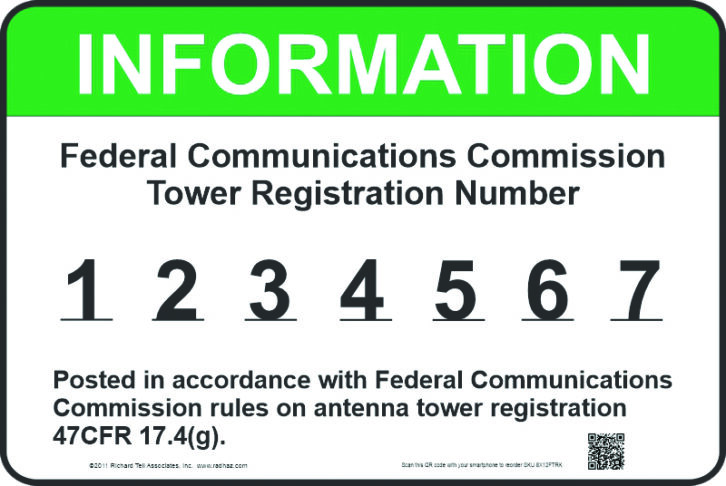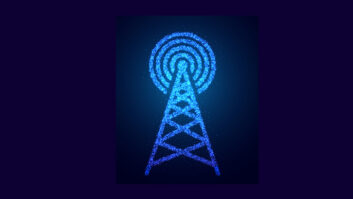There remains considerable confusion regarding the FCC’s tower and transmitter signage requirements. These are important for the safety of workers and passersby. As stations upgrade and make other modifications to their facilities, it is important that they understand and comply with the FCC’s signage rules; and broadcasters who first learned the rules years ago should refresh on the most recent changes.
What is an antenna structure?
The rules apply to antenna structures, which are defined at §17.2 of the FCC’s rules as any structure used to support antennas that transmit or receive radio energy, including the antennas and appurtenances mounted on them.
The rules apply from the time of construction until they are dismantled. The structure must be registered with the commission and obtain an Antenna Structure Registration (ASR) and comply with FCC notification requirements. See: §17.7.
Antenna Structure Registration
Once the commission issues the Antenna Structure Registration, the FCC Form 854R assigns a unique ASR Number to the antenna structure. The structure owner must then immediately provide all tenant licensees and permittees notification that the structure has been registered and a copy of either the Form 854R or the ASR number and a link to the FCC antenna structure website. This notification may only be done electronically.
Except in cases where the owner had been notified by a federal, state or local government entity that physically posting a notice would detract from the appearance of a historic landmark, an ASR number must be displayed conspicuously visible and legible from the publicly accessible area nearest the base of the antenna structure along the publicly accessible roadway or path. See §17.4(g). The rule requires that:
- Where an antenna structure is surrounded by a perimeter fence, or where the point of access includes an access gate, the ASR Number should be posted on the perimeter fence or access gate.
- Where multiple antenna structures having separate ASR Numbers are located within a single fenced area, the ASRs must be posted both on the perimeter fence or access gate and near the base of each antenna structure.
- If the base of the antenna structure has more than one point of access, the ASRs must be posted so that it is visible at the publicly accessible area nearest each such point of access.
- Materials used to display the Antenna Structure Registration Number must be weather-resistant and of sufficient size to be easily seen where posted.
Points 2 and 3 above bear emphasis. Where more than one publicly accessible access point exists, the rules require posting at each access point location and where a single perimeter fence surrounds multiple antenna structures, the registration must be posted at all access points, and at the base of the structure. This enables FAA and commission personnel, as well as members of the public, to identify a particular structure quickly and easily should it be necessary to report a lighting outage or other air safety hazard.

Transmitter site posting
Commission rules once required the posting and maintenance of broadcast licenses and related information in specific locations, including the transmitter site. Broadcast license posting was one of the oldest rules, predating even the establishment of the commission itself. The Federal Radio Commission promulgated the earliest iteration of broadcast license posting requirements as early as 1930.
Subsequently, commission decisions expanded the license posting requirements to require that records be kept and posted at specific locations, ostensibly to ensure that information regarding station authorizations, ownership and contact information was readily available and easily accessible to the commission and public but provided no explicit rationale for such rules.
In 2018 the commission eliminated the requirement to post broadcast licenses and related information in specific locations to further modernize its rules and stating it would remove unnecessary regulatory burdens that impede competition and innovation in the media marketplace.
The commission found the requirements to physically display licensing documents at the broadcast facilities were often ineffective. Transmission sites are often surrounded by security fencing that limits public access to any posted information and the requirement to post licenses at the transmitter site have been rendered obsolete by the internet, which allows the public to view ownership information remotely.
It concluded that this trend, together with the elimination of the broadcast main studio rule, has rendered the physical posting of licenses out of step with technology and its other rules.
Instead, the commission explained, broadcast station licenses and other authorizations are currently accessible online through several commission databases, including the commission’s Licensing Management System (LMS), and Universal Licensing Service (ULS) as well as the Online Public Inspection File of full-power and Class A television stations and AM and FM radio stations.
Furthermore, orders and dispositions regarding station construction or facilities operation may be accessed through the commission’s online licensing databases. Moreover, the contact information first responders need is readily available through the commission database and antenna structure registration numbers allow first responders and others to rapidly identify the owner of a tower structure.
Conclusion
The bottom line is that licensees are no longer required to post their FCC licenses at the transmitter site. Tower owners must provide all tenant licensees and permittees notification that the structure has been registered and a copy of either the ASR registration form or the ASR number and a link to the FCC antenna structure website. The ASR number must be displayed conspicuously and visibly near the base of the tower and at the closest publicly accessible location near the antenna structure base and at each access point location when more than one exists.
This column is for general information purposes only and should not be relied upon as legal advice pertaining to a specific factual situation. Legal decisions should be made only after proper consultation with a legal professional of your choosing.






